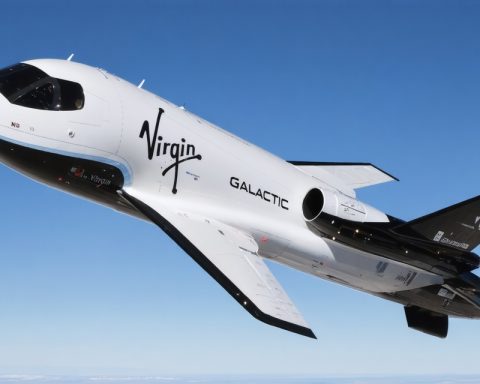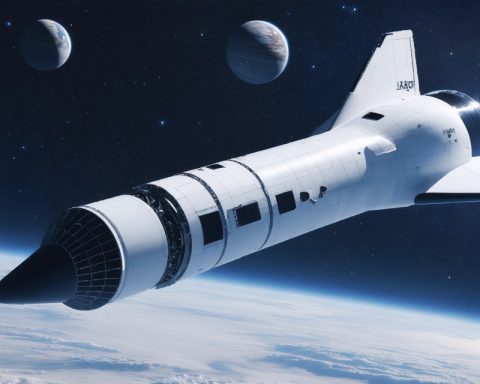SpaceX’s Starship rocket soared skyward during its latest test flight, but it would soon face an unexpected fate. After a remarkable attempt to catch the returning booster using mechanical arms, known as “chopsticks,” the spacecraft met its end in a spectacular malfunction.
Launched from Boca Chica, Texas, on January 16, the upgraded Starship was on a mission that involved launching ten dummy satellites. However, the excitement turned to concern as the six engines of the massive rocket shut down sequentially, leading to a rapid disassembly just over eight minutes into the flight. The last communication indicated the rocket was at an altitude of 90 miles, moving at a staggering speed of 13,245 mph.
Although the booster successfully returned and was captured by the launch tower’s apparatus, the joy was overshadowed by the failure of the spacecraft itself. A spokesperson from SpaceX reflected on the mixed emotions, acknowledging the success of catching the booster but lamenting the loss of the ship.
Elon Musk hinted at potential causes for the incident, suggesting that fuel leaks may have contributed to the excessive pressure that caused the breakdown. The company plans to implement safety measures, including enhanced fire suppression and regular checks for leaks.
As the most powerful rocket developed to date, Starship has crucial implications for future space missions, including NASA’s plans to use it for lunar landings and Musk’s aspirations for Mars exploration.
Far-Reaching Implications of SpaceX’s Starship Test Flight
The recent test flight of SpaceX’s Starship not only showcases the technological ambitions of private aerospace firms but also carries significant implications for society and the global economy. As the race for space exploration accelerates, countries worldwide are investing heavily in their own space programs, spurred by the potential for satellite deployment, telecommunications advancements, and mineral resources from asteroids. For instance, the global space economy is projected to grow to over $1 trillion by 2040, evidencing the transformative power of these advancements.
Moreover, the aspiration of interplanetary colonization raises questions about humanity’s future. The success or failure of ventures like Starship directly affects public sentiment towards space exploration, influencing funding and policy decisions. Failure, as experienced in this recent flight, can provoke skepticism, potentially stalling progress among other companies and governmental agencies reliant on similar technologies.
Additionally, the environmental effects tied to rocket launches are increasingly scrutinized. The launch and testing phases emit significant greenhouse gases, impacting atmospheric conditions. As private companies innovate, they also face pressure to ensure sustainable practices in rocket development. Future trends may involve a pivot toward greener technologies, as public awareness of climate change profoundly alters consumer and governmental expectations.
Ultimately, the path paved by Starship’s ambitions will redefine not just space exploration, but the economic, ecological, and cultural landscapes of Earth itself. The resiliency demonstrated in the face of setbacks may serve as a driving force for innovations that can address the challenges of our time, pushing humanity closer to the stars while demanding responsibility toward our home planet.
The Future of Space Travel: What We Learned from SpaceX’s Starship Test Flight
Understanding the Starship Test Flight Incident
SpaceX’s recent test flight of the Starship rocket has brought significant attention to the evolution of space technology. Launched from Boca Chica, Texas, on January 16, this flight aimed to assess the capabilities of the upgraded Starship while deploying ten dummy satellites. However, the flight concluded dramatically, highlighting both the triumphs and challenges of advancing rocket technology.
Key Takeaways from the Test Flight
1. Technical Specifications of Starship
Starship is designed to be the most powerful rocket ever created. It features six Raptor engines capable of producing incredible thrust, with a fully assembled vehicle height of around 120 meters. This massive rocket is intended for a variety of missions, including carrying cargo to the Moon, Mars, and beyond.
2. Innovations in Recovery Mechanisms
The attempt to catch the returning booster with the mechanical arms, referred to as “chopsticks,” was a remarkable advancement in rocket recovery. While this aspect of the mission was successful—demonstrating SpaceX’s continued innovation in reusability—the subsequent failure of the spacecraft highlights the need for rigorous testing and enhancements in recovery systems.
3. Safety Measures Going Forward
In light of the incident, SpaceX is prioritizing safety enhancements. The potential causes, including fuel leaks leading to excessive pressure, are prompting the company to implement regular checks for leaks and a more robust fire suppression system. This focus on safety reflects a growing trend in aerospace technology where failures provide critical learning opportunities.
4. Use Cases for Starship
Starship plays a crucial role in several upcoming missions. NASA plans to utilize it for lunar landings as part of the Artemis program, aiming to return humans to the Moon. Additionally, Elon Musk envisions Starship as pivotal for Mars colonization, underscoring its potential transformative impact on interplanetary travel.
Pros and Cons of the Starship Program
Pros:
– Innovative recovery technology that can significantly reduce launch costs.
– Versatility for various missions including commercial flights, lunar exploration, and potential Mars missions.
– A strong commitment to enhancing safety protocols and reducing environmental impact.
Cons:
– High-profile failures can affect public perception and investor confidence.
– The complexity of the technology necessitates extensive testing and development time.
– Safety regulations for deep-space missions remain a significant challenge.
Future Predictions: The Path Ahead for SpaceX
As SpaceX continues to refine the Starship configuration, industry experts predict that the rocket will become operational for various missions within the next few years. The trajectory of innovations in recovery and safety will likely set new benchmarks for future aerospace projects.
Conclusion
While the recent Starship flight ended in malfunction, the lessons learned will serve to advance the goals of SpaceX and the broader space exploration community. With a focus on innovation, safety, and sustainability, the future of space travel holds great promise.
For more insights into SpaceX and their ambitious plans for space exploration, visit SpaceX.



















